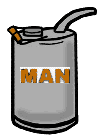|
Past Preventive Maintenance columns: Leveling—Machining
Centers and Mills Leveling—Is
It an Issue After Installation? Frequently
Asked PM Questions Machining
Center PM—Index and NC Tables Examining
Accuracies on Machining Centers Zero
Points on Machining Centers—Machining Centers vs.
Lathes Completing
Lathe Maintenance—Tailstock, Sub-Spindle, and
Zero-Point Alignment A
Closer Look at Spindles and Turrets The
Next Level: Accuracy—Checking Backlash on Lathes
Inspecting
the Electrical Cabinet Everyone's
Favorite Task—Cleaning Coolant—The
Most Ignored Fluid in your Machines It's
Summertime—Is your Chiller Working? The
Other Oils—Inspecting the Main Hydraulic Systems
|
MIKE BREEN ON PREVENTIVE MAINTENANCE |
|
Remembering Why by Michael W. Breen |
|
|
I thought this month would be a good time to step back and remember why we are doing this PM thing. With the economy the way it is, there is not a better time than right now to take care of what you have. I know that when the corporate purse strings get tight, corners start to get trimmed a little bit. The good news is: most forecasters are starting to see light at the end of the tunnel. But, in the meantime, take advantage of the situation and perform those important PMs on your machines. Self-PM Before we move on to your machines, start by doing a quick self-PM. Ask yourself these important questions: Are you doing the best you can? Are you looking at ways to cut costs? Are you showing up to work, ready to work? The answer to all of these questions should be “YES”, because getting America back on its feet is up to the workforce of America. (I know most of you are envisioning me in a skirt and holding pompoms in my hands right now, but it really is up to US.) Reduce Downtime So, why is PM so important, especially in a down market? That is a simple one. PMs stop unscheduled downtime. Unscheduled downtime adds to the cost of the part. If the part costs too much to manufacture, the company starts to lose money on the production of that part. The company then needs to increase the price of the part, which may force the customer to find someone else to produce the part cheaper. With times being a little tight, customers are being forced to continuously search for better deals. Believe it or not, there is an advantage to a slowdown in production. Number one, machines become available so that you can work on them. When you get your hands on one of these untouchable machines, be thorough, because you may not have the opportunity to work on this machine again for a long time. With more time to work on each machine, you can get much deeper into the PM process. Be smart about the parts you want to replace. If a replacement part is needed, but the part purchase is denied, take the manager out to the machine and demonstrate what will happen if the part is not replaced. PM Saves Money Conducting preventive maintenance checks saves money. With added time to work with, here are some money-saving PM tips:
Do what you can out there NOW to save a little bit, and performing PMs is one way to do this. The future is starting to look better. In the meantime, keep your chin up and communicate your ideas. It may be your idea that saves your company. Next month we are going to start talking about grinders. Talk to you then; meanwhile, get going on those PMs. Mike Breen’s career of more than 14 years in machine tool repair includes his experience as an aircraft electrician in the U.S. Army’s 101st Airborne. He is a Certified Electronic engineer, presently working as a Field Service Engineer with Ellison Machinery Company of Wisconsin. Mike invites you to share your own machine repair and maintenance experiences with him. For comments and inquiries about these articles, his e-mail address is mbreen@ellisonwi.com. - August 2001 |

 You know its getting a little rough out there when half of the Sunday comic strips refer to the sagging economy.
You know its getting a little rough out there when half of the Sunday comic strips refer to the sagging economy.